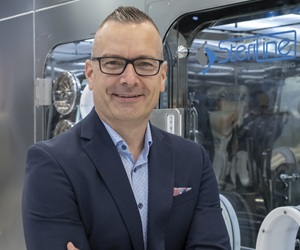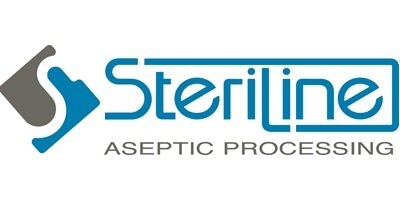World Pharma Today recently spoke with James Rorke, Vice President of North American Operations for Steriline, and Eric Brooks, Regional Sales Manager for Western USA & Mexico, to discuss Steriline’s cutting-edge robotic vial filling machine. This innovation reflects Steriline’s “zero-loss philosophy” by eliminating vial accumulation, thereby preserving the integrity of high-value pharmaceutical products and maximizing efficiency in production.
1. What inspired Steriline to develop this new robotic vial filling machine, and how does it differ from your previous models?
Steriline developed this new robotic vial filling machine to further our commitment to protecting high-value pharmaceutical products and maximizing production efficiency. This new machine model completely eliminates accumulation, minimizing the risk of vial-to-vial contact during processing. This is particularly important for high-value products, where preserving the integrity of every vial is essential. This new model reflects our ‘zero-loss philosophy’ at an advanced level, ensuring that more of each batch reaches the final packaging stage in optimal condition. The small footprint, compact isolator design maximizes the efficient use of valuable clean room space.
2. Can you share insights into the specific technologies or innovations used in this machine that enhance accuracy and efficiency in vial filling?
The new machine incorporates cutting-edge robotics and vision solutions designed to ensure precision and efficiency. Our focus on zero loss means we’ve implemented technologies that minimize product waste and ensure a high yield of good vials per batch. Exceptions during filling, stoppering and capping are sensed and corrected automatically by the machine with no human intervention. Additionally, the machine’s compact design enhances its adaptability, allowing it to integrate seamlessly within existing cleanroom infrastructures without sacrificing performance. This level of precision and space efficiency is a significant step forward in vial filling technology.
3. How does this machine address key challenges in pharmaceutical manufacturing, especially with respect to sterility and contamination control?
Maintaining sterility and preventing contamination are central to the design of our new robotic vial filling machine. The machine eliminates human intervention which is the largest risk for contamination in the aseptic process. By using robotics to handle both routine production tasks and interventions during exception handling, we greatly reduce the risk of contamination. This approach aligns with Steriline’s broader goal of reducing aseptic interventions and maintaining an environment of stringent contamination control throughout the production process.
4. What sort of feedback have you received from initial users or testers, and how has that shaped the final design?
Initial feedback from industry professionals has been overwhelmingly positive, with particular praise for the machine’s compact footprint. Many users appreciate that the small, efficient design allows for easy integration into existing cleanrooms and production facilities. This feedback reinforced our focus on creating a space-saving, flexible solution that fits within current infrastructure without the need for extensive reconfiguration.
5. How does the machine’s design accommodate varying vial sizes and production volumes, and what flexibility does it offer manufacturers?
Our robotic vial filling machine has been engineered to handle a range of vial sizes and production volumes, offering manufacturers the flexibility to adapt to changing production demands. By eliminating vial accumulation and ensuring careful handling, it allows for a versatile production line that can be adjusted without compromising vial integrity. This adaptability is a key feature for manufacturers who need to process different container types and sizes efficiently.
6. Can you elaborate on any unique robotic or automation features that make this machine stand out at CPHI Milan?
At CPHI Milan, this machine is being showcased for its innovative use of robotics to minimize aseptic interventions. Our approach is to deploy robotics not only for vial filling but also for handling interventions, ensuring that the same robotic mechanisms perform both tasks. This multi-purpose design avoids additional complexity while enhancing sterility, making it a standout choice for manufacturers looking to reduce human interaction with the product.
7. What kind of training or support does Steriline provide to manufacturers to ensure they can maximize the machine’s capabilities?
Steriline provides comprehensive training and global support to ensure manufacturers can fully utilize the capabilities of our machines. With an expanding network of remote technicians and trainers worldwide, we offer on-site and remote support to address operational and maintenance needs quickly. This global presence ensures that our customers receive the expertise they need, no matter where they are located, allowing them to get the best possible performance from their equipment.
8. How does the new machine fit within Steriline’s broader vision for the future of pharmaceutical manufacturing and automation?
This new machine aligns with Steriline’s vision of transforming pharmaceutical manufacturing by reducing the need for human interventions in aseptic processes. Our focus is on deploying robotics for both production and intervention tasks, minimizing complexity while maintaining sterility. This direction supports our ultimate goal of enhancing operational efficiency and product safety by minimizing human involvement in critical stages of the manufacturing process.
9. Are there any future updates or developments planned for this machine or for the Steriline product line in general?
Steriline is committed to continuous improvement and innovation. While specific updates to this machine will be driven by user feedback and industry trends, our product line will continue to evolve with advancements in robotics , automation and AI. Future developments will focus on further reducing human interaction, increasing production flexibility, and integrating new technologies that enhance precision and sterility.
10. How does Steriline see the role of robotics evolving in the pharmaceutical manufacturing industry over the next 5–10 years?
We believe robotics will play an increasingly central role in pharmaceutical manufacturing, particularly in eliminating aseptic interventions by humans. In the next 5–10 years, we anticipate that robotics will handle a larger scope of operations, from production to quality control and even handling unexpected situations autonomously. Steriline envisions a future where robotics streamline pharmaceutical manufacturing, making processes safer, more efficient, and adaptable to a variety of production needs.






















